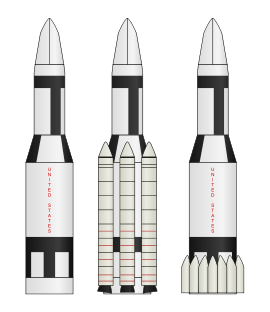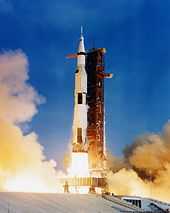Saturn II
 Saturn II proposals: Left to right, INT-17, 18 and 19. | |
| Function | Orbital launch vehicle |
|---|---|
| Manufacturer | North American (S-II) Douglas (S-IVB) |
| Country of origin | United States |
| Size | |
| Height | 167 feet (51 m) |
| Diameter | 33 feet (10 m) |
| Mass | 724,000 pounds (328,000 kg) |
| Stages | 2 |
| Capacity | |
| Payload to LEO | 47,000 pounds (21,000 kg)[1] |
| Launch history | |
| Status | 1967 Study Cancelled |
| Launch sites | LC-39, Kennedy Space Center |
| Total launches | 0 |
| First stage - S-II | |
| Engines | 5 Rocketdyne J-2 |
| Thrust | 1,000,000 pounds-force (4,400 kN)[1] |
| Burn time | 360 seconds |
| Fuel | LH2/LOX |
| Second stage - S-IVB | |
| Engines | 1 Rocketdyne J-2 |
| Thrust | 225,000 pounds-force (1,000 kN) |
| Burn time | 400 seconds |
| Fuel | LH2/LOX |
The Saturn II was a series of proposed American Expendable launch vehicles, proposed by North American Aviation in 1966, derived from the Saturn V rocket that was used for the Apollo lunar program.[1] It was, essentially, a version of the Saturn V with the lowest stage removed, producing a two-stage design with a payload intermediate between the Saturn IB and V, delivering about 46,000 pounds (21,000 kg) to low earth orbit.
Concept
There was a large payload gap between the Saturn IB's 19,000 kg low-earth orbit capacity and the two-stage Saturn V's 100,000 kg capability.
In the mid-1960s NASA's Marshall Space Flight Center (MSFC) initiated several studies to extend the capabilities of the Saturn family. The studies examined a number of Modified Launch Vehicle (MLV) configurations based on the Saturn IB and Saturn V launch vehicles as well as Intermediate Payload (INT) launch vehicles based on modified Saturn stages (MS-IB, MS-IC, MS-II, and MS-IVB).
Martin Marietta (builder of Atlas, Titan vehicles), Boeing (builder of S-1B and S-1C first stages) and North American (builder of the S-II second stage) were three of the companies that provided responses.
North American considered the best way to fill the gap was to use the Saturn V's second stage, the S-II, as the first stage of an intermediate launch vehicle.
The basic concept of the Saturn II was to save money by ceasing production of the Saturn IB rocket, and replacing it with launch vehicles built entirely with current Saturn V components. This would allow closing down production lines for the S-IB first stage, and would allow for more efficient integration of rocket systems.
It would have replaced the Saturn IB, which had a maximum payload capability of 46,000 pounds (21,000 kg), for launching spacecraft into low Earth orbit.
Design
The Saturn II in its most simple form, was a Saturn V, without the Boeing built S-IC first stage. The Saturn V's second stage S-II became the first stage, and the S-IVB used on the Saturn IB and Saturn V, became the second stage.
Several derivatives were also considered, but before any version could be put into production, production of all Saturn variants was stopped in favor of launching all future payloads from the Space Shuttle.
Saturn INT-17
The Saturn INT-17 was the first derivative of the Saturn II to be considered. It differed from the baseline Saturn II in having a modified first stage. The original five J-2 engines were to be replaced with seven HG-3-SL engines, which were thought to offer better performance.[1] The concept was dropped when it was decided that J-2 engines would have better overall performance, and be more reliable and cost-effective.
Saturn INT-18
The Saturn INT-18 was designed to be supplemented by two or four Titan SRBs. The UA1204 and UA1207 boosters were considered, with the most powerful configuration, featuring four UA1270 boosters, capable of placing 146,000 pounds (66,000 kg) of payload into Low Earth orbit.
Designers also considered changing the amount of fuel loaded into the rocket, and whether to ignite the S-II stage on the ground, or whether to launch using the solids, and start the main stage in flight. Some designs even omitted the S-IVB stage, leaving just a single S-II stage, and boosters.
Saturn INT-19
The Saturn INT-19 also used SRBs to supplement the power of the S-II, however it used smaller solids, derived from the first stage of the Minuteman missile. It was intended to use between four and twelve solids, with some being started at lift-off, and some being started in flight.
The heaviest configuration would have consisted of twelve SRBs, with eight started at launch, and a further four started after the first group had been jettisoned. It would have been capable of lofting a payload of up to 34,000 kilograms (75,000 lb).[1]
The S-II stage would have been modified as well. The J-2 engines would have been adjusted to give them a reduced expansion ratio, making them more suited to operations at sea level. The disadvantage of this is that the rocket would have been unable to even get off the ground without augmentation from SRBs.[1]
See also
References
- Encyclopaedia Astronautica Saturn II
- Final Report - Studies of Improved Saturn V Vehicles and Intermediate Payload Vehicles (PDF format), October 7, 1966.
| ||||||||||||||||||||||||
